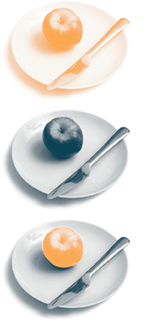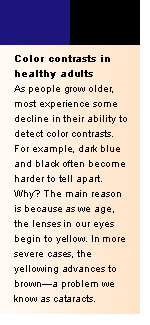 Scientist Spotlight:
Scientist Spotlight:
Alice Cronin-Golomb, Ph.D.
DIRECTOR, VISION AND COGNITION LABORATORY, BOSTON UNIVERSITY
More and more, neuroscientists are uncovering the important relationship between our senses—such as hearing or vision—and our cognitive abilities. These findings have real-world significance. Scientists and doctors are beginning to understand that programs or therapies that address deficits in sensory abilities might serve to ameliorate cognitive problems, too. While the science is highly complex, the solutions can be surprisingly simple.
A Palette for the Alzheimer's Palate
 Many chefs will tell you that food presentation is essential to the diner's enjoyment of a meal. Alice Cronin-Golomb, Professor of Psychology and Director of the Vision and Cognition Laboratory at Boston University, might agree. The Alzheimer's patients she works with enjoy more of the meal when it is served on a brightly colored plate. A bright color that contrasts with the color of the meal helps people with Alzheimer's disease (AD) tell the food and drink apart from the tableware.
Many chefs will tell you that food presentation is essential to the diner's enjoyment of a meal. Alice Cronin-Golomb, Professor of Psychology and Director of the Vision and Cognition Laboratory at Boston University, might agree. The Alzheimer's patients she works with enjoy more of the meal when it is served on a brightly colored plate. A bright color that contrasts with the color of the meal helps people with Alzheimer's disease (AD) tell the food and drink apart from the tableware.
Professor Cronin-Golomb has done tremendous research on visual dysfunction in patients with AD. She and her colleagues have demonstrated that AD affects areas of the brain that are responsible for vision, resulting in widespread visual deficits. These deficits in vision can contribute to the decline of people with Alzheimer's in myriad ways. Perhaps surprisingly, one way is in how much they eat.
Losing Weight
About 40% of people with AD lose weight, sometimes dropping to dangerous lows. Weight loss in patients with AD has been generally assumed to result from depression, as well as patients' inability to feed themselves and their tendency to focus on only one food at a time.
Based on their research, Dr. Cronin-Golomb and her colleagues believed that there was a visual reason for poor appetites. In earlier studies, they had determined that Alzheimer's affects the occipital lobe and related areas near the back of the brain—the areas responsible for sensitivity to visual contrast and the perception of color. They realized that AD patients were probably eating less in part because they couldn't distinguish their food from the tableware. Imagine chicken and mashed potatoes served on a white plate, with milk in a white cup. Not much contrast.
Red & Blue Plates
Dr. Cronin-Golomb and her colleagues decided to study the eating habits of people with advanced AD who still fed themselves. The team monitored the food and drink intake of nine residents at the Edith Nourse Rogers Memorial Veterans' Affairs Medical Center in Bedford, MA for 30 days. For the first ten days the meals were served on white plates with stainless steel flatware and white cups, all of which, according to the study, "is standard for this facility." The meals the residents ate were also the standard fare. For the next ten days, meals were served on high-contrast red plates, the residents drank from red cups, and they ate with red flatware. The size and shapes of the tableware were similar to those used by the facility, and the food was the regular lunch and dinner that the facility serves. Finally, for the last ten days, the residents' meals were again served on the white tableware. 
A year later, the research team did a follow-up study. Using the same procedures as the first study, they measured how much AD patients consumed during a 70-day period in which meals were served for 10 days on high-contrast tableware (this time blue instead of red) and 10 days each on low-contrast pastels (pink and light blue), alternating with 10-day periods on the original white tableware.
The results? For the first study (with the red tableware), the researchers found that participants ate an average of 27% more from the high-contrast red plates than from the white plates. They also found that the residents drank an average of 83.7% more from the red cups. In the follow-up study, the meals on the high-contrast blue tableware, like the red, showed significant change, with an average of 25.1% increased intake of food and 29.8% of liquid. The meals on the low-contrast pastel tableware showed no change, indicating that it was indistinguishable from the white in terms of functional contrast. Taken together, the studies showed that color (red vs blue) was not as important as the amount of contrast between the tableware and the meals.
Why It Matters
This experiment may seem simple, but it has important implications. First, it offers caregivers an easy solution to one of the life-threatening effects of AD: serious undernourishment and weight loss. Just as important, it underscores a new avenue for understanding and preventing the effects of AD. Following in Dr. Cronin-Golomb's footsteps, researchers are working hard to figure out how to address—even reverse—visual dysfunctions as part of a strategy for preventing or slowing the progression of Alzheimer's disease.
Alice Cronin-Golomb, Ph.D. is a member of the Posit Science Scientific Advisory Board.






 English
English
 Français
Français


